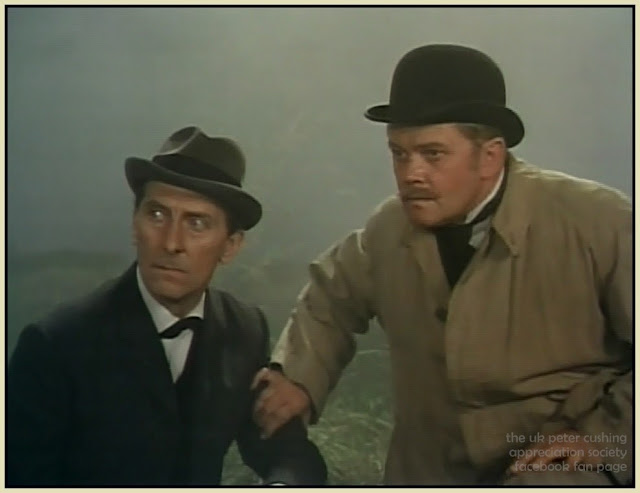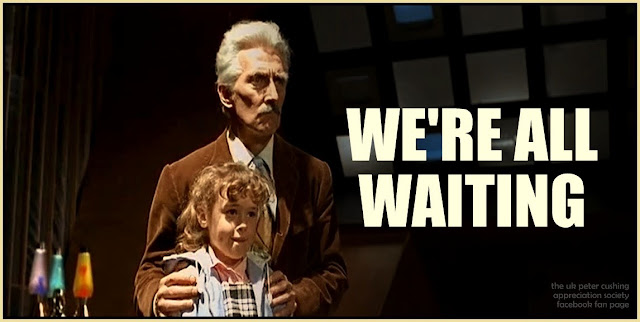According to legend, the heirs of the
Baskerville family are all doomed to meet untimely demises at the claws of the
Hound of the Baskervilles; Sherlock Holmes is called in to uncover the truth…
Sir Arthur
Conan Doyle’s career as a writer is inextricably linked to his most famous
creation, Sherlock Holmes. This was not what the author himself had in
mind, however, and indeed he eventually tired of the popularity of the
character and grew to resent having to serialize his adventures. He decided
to kill the master detective off in 1893, with The Final Problem, wherein
Holmes takes a tumble off Reichenbach Falls while struggling with his nemesis,
the criminal mastermind Professor Moriarty. Public outcry was so strong
that Doyle eventually felt compelled to revive the character. Published
in 1901 and 1902, The Hound of the Baskervilles – its action set before the
incidents dramatized in The Final Problem – was the first of the “new” Holmes
adventures; it has since become the most popular of the various Holmes
adventures. It also remains far and away the most heavily adapted for
film and television. A complete rundown of the various versions would
call for an article in itself; suffice to say, it was serialized in Germany on
at least two occasions during the silent era, in addition to several other
British and German versions, many of which are now believed to be lost.
The 1939 version from 20th Century Fox version is remembered less
for its (sometimes spotty) merits as a film than for being the first to
introduce the now-legendary pairing of Basil Rathbone and Nigel Bruce as Holmes
and Watson. Rathbone remains the screen’s definitive Holmes, while
Bruce’s less-than-canonical account of Watson remains a sore point with many purists.
The Fox version has some nice set pieces but lumbers under the pedestrian
direction of Sidney Lanfield.
An obscure German version from the 1950s
would follow, but it would be up to Hammer Films to offer up the next
significant adaptation. Peter Cushing made his debut as Holmes, with
Andre Morell as a much-truer-to-Doyle incarnation of Watson. Capitalizing
on the success of their Curse of Frankenstein (1957) and Dracula (1958), Hammer
also saw fit to cast Christopher Lee in the role of Sir Henry Baskerville, thus
giving the actor his first chance to play a romantic lead. This version
has many fine points to recommend notably Morell’s Watson and a tour de force
bit of directing from Terence Fisher during the film’s extended opening
flashback sequence – but it suffers from taking too many liberties with the
text and has a generally cramped and claustrophobic quality, despite some
superb cinematography by the great Jack Asher. Cushing’s neurotic take on
the detective, however, did not really connect with audiences – and the film
failed to repeat the box office takings of Hammer’s straight horror films, thus
quashing the potential for a series of Holmes adventures.
The next
version is the one under discussion, produced by the BBC , with Cushing reprising
his turn as Holmes and Nigel Stock stepping in to play Watson, as he had done
for the entire run of the BBC series. Later versions would range from the
serious to the comical – Paul Morrissey’s slapstick-infused version from 1978,
starring Peter Cook and Dudley Moore, is often reviled, but taken on its own
lighthearted terms, it offers some genuine chuckles – with wildly uneven
results. A 1972 TV version starring Stewart Granger and Bernard Fox was
one of the worst, while Granada ’s miniseries version with Jeremy Brett and
Edward Hardwicke was something of a disappointment. Ultimately, for a
story adapted for the screen on so many occasions, the definitive version has
proved elusive; in many respects, this two-part BBC version is as good an
option as any, for at least it remains true to the basic particulars of the
story, and offers up a fine Cushing performance at its center. But like every other extant version to date,
it most definitely falls way short of the potential offered by the subject matter.
Like other entries in the BBC series, the film
suffers, aesthetically, from the mixture of being shot on film and video – the location
photography is much appreciated, however, and helps to add a sense of menace to
the proceedings. The script is dialogue
heavy, but this is hardly an issue when Cushing is on hand to help sell the
material. He again displays great
chemistry with Stock, and the two actors are quite skilled at bringing their
characters to life. Director Graham
Evans shows himself to be more competent than inspired, and the pacing tends to
slacken when Holmes is off screen – which, this being relatively faithful to
the text, poses a problem in the mid-section of the narrative.
The supporting cast includes Gary Raymond,
then part of the ensemble of the popular Rat Patrol TV series and later to
headline on the better episodes of The Hammer House of Horror, Two Faces of
Evil. Raymond does a capable job as Sir
Henry, though he inevitably lacks the sheer presence of Lee in the earlier
adaptation. Ballard Berkeley, later to
find small screen immortality as the delightfully dotty Major in Fawlty Towers,
puts in an appearance as Sir Charles Baskerville; he had earlier costarred with
Cushing in Cone of Silence (1960). David
Leland makes for a less blustery and overtly suspicious-looking Dr. Mortimer
than Lionel Atwill and Francis DeWolff, in the Fox and Hammer versions,
respectively; he would later pop up in comedic relief capacity in Roy Ward
Baker’s Scars of Dracula (1970).
This version of Hound may not offer up the blood and
thunder approach of the Hammer version, but it remains a very competent
adaptation in its own right.
It’s truer
in spirit and particulars to Doyle’s original tale, and it makes for a cozy way
of whiling away a couple of hours on a rainy afternoon; mystery lovers with a
love of old fashioned whodunnits will be properly entertained.
Review: Troy Howarth
Images: Marcus Brooks
Review: Troy Howarth
Images: Marcus Brooks
Please Join Us At The Official FACEBOOK FAN PAGE of The PCAS : HERE


















































